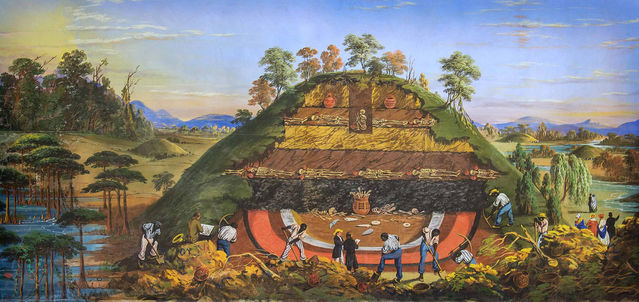Epigenetics
The Things We Carry: What Our Ancestors Didn't Tell Us
What behavioral epigenetics reveals about how trauma can transcend generations.
Posted October 24, 2017 Reviewed by Ekua Hagan

What if your maverick blood sugar, your obstinate obesity, the asthma that has plagued you throughout your life, or the nightmares from which you wake numb and shaking, are not the result of your own lived experience, but are instead manifestations of hidden or unspoken traumas bequeathed from past generations? What if what happened to your great-grandparents has shaped who you are through a mix of external circumstances and epigenetic expression?

In the old Darwinian understanding of genetic inheritance, evolution was thought to be a gradual process that occurred over eons as a species evolved to adapt to a changing environment. On his trip to the Galapagos Islands in 1835, Darwin observed several species of finches. He speculated that the birds probably originated from the same ancestor finch and wondered what could now account for the slight variation among the birds. He noticed that the beaks of the ground-dwelling nut eaters were uniquely suited for their predominant food source, nuts, while the tree-dwelling insect-eating finches had slightly different beaks. From this observation, he postulated that spontaneous mutation accounted for the difference in finch beaks and that a process of natural selection allowed for the mutant birds to thrive.
In The Epigenetics Revolution: How Modern Biology Is Rewriting Our Understanding of Genetics, Disease, and Inheritance, Nessa Carey, a molecular biologist, writes that our understanding of DNA based on Mendelian and Darwinian principles, and the work of Watson and Crick, cannot sufficiently explain rapid changes in species that occur in a single generation. As she sees it, epigenetics is revolutionizing how we understand biology. Whenever two genetically identical individuals are non-identical in some way we can measure, epigenetics is at play.

Take, for example, identical twins who have the same DNA code. In childhood, they appear to be identical, but as they age and are subject to different environmental and emotional conditions, they may lose their look-alikeness and develop different physical characteristics and medical conditions. Let’s say both twins carry a genetic mutation that predisposes a person to get breast cancer. How do we explain only one twin getting the disease? If DNA were completely responsible for shaping a person, we would expect the twins to be identical in every way, including which heritable diseases they get. This isn’t what necessarily occurs. Epigenetics explains changes in gene activity and expression not dependent on our DNA sequence.
Epigenetics is one way to explain the connection between nature and nurture, or as Carey puts it, “how the environment talks to us and alters us, sometimes forever.” The process of epigenetics changes the chemical modifications surrounding and attaching to our genetic material that in turn changes the way genes are switched on or off without altering the genes themselves.
I was drawn to epigenetics while doing research on transgenerational trauma for my second novel which explores how the hidden or suppressed stories within a family line can shape future generations. In my own life, I couldn’t account for the dread that would sometimes descend on me for no apparent reason. It seemed to me there was something vaster, more amorphous and inexplicable at work than the usual psychological culprits. I needed to understand what it was. I began to wonder if the darkness I carried had its source in the suffering of unknown ancestors whose history of banishment and exile was in my blood.
Epigenetics offered some answers.

In a landmark epidemiological study that investigated the effect of famine in pregnant Dutch women during The Hunger Winter, from November 1944 through the spring of 1945, researchers found that a mother’s starvation affected the birth weights of children who had been in the womb during that difficult period. The children of mothers who were malnourished during their first trimester had children with higher rates of obesity in later years. The traumatic stress in the wombs of the Dutch mothers during The Hunger Winter somehow transferred effects to the children, grandchildren, and even the great-grandchildren of the original mothers.
In the relatively new field of behavioral epigenetics, Holocaust studies and research have studied the physiological and psychological effects of genocide, ethnic cleansing, and other overwhelming emotional experiences such as occur from natural disasters, rape, the loss of a child, or an abusive home situation. Their findings have documented that trauma can affect the expression or suppression of certain genes, not only for the person involved but also for succeeding generations.

In a recent talk on NPR, the award-winning author Jacqueline Woodson raises the question of “ancestral memory” in the descendants of African slaves who crossed the Atlantic in slave ships under horrific conditions. Could the prevalence of high blood pressure among African-Americans today be an epigenetic response to the trauma experienced by the slaves who survived the voyage from Africa? Woodson speaks of her fear of swimming in large bodies of water, attributing this fear, which she shares with other African-Americans, to a set of behaviors loosely defined as “The Middle Passage Syndrome.”
What about the effects of familial shame, guilt, despair, rage, and hopelessness? Can these be passed on to descendants? Evidence points to the affirmative. Silence, concealment, denial, and dissociation are ways individuals and families cope with overwhelming experiences. Many of us are raised with the dictums: It’s water under the bridge. The past is the past. Don’t talk about it. Unfortunately, what is unthinkable or unmentionable does not disappear from our psyches. While the horror may be suppressed in the victim and even her offspring, third and fourth generations often feel “haunted” by something they can’t name. Nightmares, depression, anxiety, and somatic metaphors that stand for the initial trauma resurrect the historical suffering in new forms.

In her book, The Ancestor Syndrome: Transgenerational Psychotherapy and the Hidden Links in the Family Tree, French psychotherapist Anne Ancelin Schützenberger describes a patient she calls “the butterfly chaser.” The case offers a fascinating instance of how ancestral traumas can influence and shape an individual who has no knowledge of them:
“The patient was a geology lover. Every Sunday he went out looking for stones, collecting them and breaking them. He also chased butterflies, caught them, and stuffed them in a jar of cyanide before pinning them up.”
Distraught with his life, the man went for counseling. His analyst decided to investigate the man’s family, going back several generations. What the analyst learned was that the patient had a grandfather who nobody mentioned and who was a secret. The doctor convinced the patient to find out more about the grandfather. In doing so, the troubled patient discovered that his mother’s father had done “shameful things.” Among other unlawful deeds, he was suspected of being a bank robber and was sent into forced labor, in French, casser les cailloux, which means, “to break rocks.” Later, the grandfather was executed in the gas chamber. The rock-breaking, butterfly-gassing grandson had known none of this.
Schützenberger continues: “In a certain number of cases, pastimes, hobbies or leisure activities which can derive from family secrets, are surprisingly full of meaning.” Her book was written in 1998, before knowledge of epigenetics, but she writes: “strange behavior, illness or delirium” are often the result of these inherited “ghosts” who are half-buried in our unconscious, like a secret buried alive.
However, we are more than our ghosts, more than the composite of our memories, inherited or otherwise. In The Developing Genome: An Introduction to Behavioral Epigenetics, developmental cognitive neuroscientist David S. Moore cautions against viewing epigenetics as “fetal programming.” Writing about the effects of abusive parenting on subsequent generations, he finds recent research encouraging: “The possibility that these sorts of patterns reflect epigenetic effects is exciting because epigenetic effects are potentially reversible, either through interventions with specific drugs or through treatment programs that provide other experiences.”

What might these other experiences be? To this point, Jungian analyst James Hollis, in his book Hauntings: Dispelling the Ghosts Who Run Our Lives, asks: “How do we exorcise the haunting of our separate histories? How do we see outside the lens ground for us by fate…?”
His answer aims to inspire creativity. “The difference between us and the mill horse is our capacity for imagination,” he writes, reminding us that our neuroses keep us stuck in old patterns. Our complexes “can only replay the old events, scripts, and moribund outcomes of their origin.”
In suggesting we look to our imaginations as a portal to healing, Hollis leads us back to the ancient arts of ceremony and ritual, and to our in-dwelling creative spirits that remain alive no matter what terrible thing has happened to us. Here might be the way, exclusive of therapy and medication, to re-imagine and remember who we are beyond our traumas. We are our own best shamans, capable of connecting to those divine forces that lie outside our ego’s tunneled and sometimes tortured vision.
Healing trauma involves movement, intrapsychic and literal. If trauma freezes us to a spot in time, a place-memory, and to inherited patterns of behavior, self-expression in the form of creative ceremony—dancing, singing, sculpting—inspires new energies to flow. Pick up your drum! Dance under the moon! Start a journal. Transformation begins with following your brave heart into the unknown.




